Start Food Composting
By Save Food Cut Waste
Being a green activist and the founder of the Eco Walk the Talk blog, Bhavani Prakash advocates environmental education and also food composting.
Her journey on composting started because she does a lot of cooking at home, and goes through a lot of veggies and fruits in a day. She didn’t want all the veggie and fruit peel waste to go down the chute in a plastic bag and get to the incinerator.
She had seen organic farmers compost their biomass waste in farms, but really wanted to find a way to do it in an apartment using a closed container. She stumbled upon an article in a magazine on home composting, and followed the concept, researched it a bit more, and made adjustments through trial and error and have been successfully composting since then.
Bhavani explains the type of food waste she uses and how to maintain a compost bin:
All veggie and fruit peel waste, coffee grinds, tea leaves, paper with not too much print on it, dried leaves, yard waste, cardboard boxes, tissue rolls (the brown cylinder inside). A compost bin is very forgiving, even if you make mistakes, because you can always adjust it. If there’s too much moisture, add some browns (paper, cardboard, dried leaves) to soak up the extra moisture. If it starts smelling, which it shouldn’t, then it means it’s not getting enough air, so just give it a good stir. If it’s too dry, then sprinkle some water regularly. Once you start and taste success, it’s really easy to keep doing it.
The compost is used by Bhavani for her rooftop garden where she grows veggies and fruit like sugarcane, banana, sweet potato, beans and gourd, and a variety of herbs and greens organically.
Try composting your fruit and vegetable scraps at home or in the community garden, and produce compost for gardening.
What is Composting
Composting is the natural decomposition of organic material (from plants and animals) by microorganisms, into a dark brown crumbly organic substance called compost. Compost mixed with soil is beneficial for growing plants as the compost retains soil moisture, improves soil structure and provides nutrients.
There are different types of composting methods such as using a typical compost heap (outdoor or in a compost bin), using earthworms in vermicomposting, or using effective microorganisms in Bokashi composting.
Composting Tips
Instead of throwing away your fruit and vegetable scraps, which ends up being incinerated, why not try composting them at home or in the community garden? The compost can be used for gardening and helps you save money by reducing the use of fertilisers.
The National Parks Board (NParks) has published several tips on composting and also a short video on composting using a tumbler bin:
You can also try composting your fruit and vegetable scraps at home with these 4 easy steps from Zero Waste Singapore:
1. Prepare a Compost Bin
You can buy a compost bin for a few hundred dollars but we recommend building one yourself. All you need is a cheap plastic bin with a lid, such as the common black dustbin or the rectangular-sized dustbin. The size of the compost bin depends on your family size, the amount of waste disposed and where you want to place it.
It is important to ensure that air can circulate freely in the compost bin as composting is an aerobic process where microorganisms require oxygen to decompose the waste. If there’s insufficient air, the process becomes anaerobic and produces gases such as methane, ammonia and hydrogen sulphide, which causes smell problems.
To ensure good air circulation, drill small holes on the lid and at the bottom and sides of the bin. The bin should be placed at an airy spot without direct sunlight. The bin should also be elevated from the ground by placing two bricks or stones at each end of the bin bottom.
Use cardboard to line the sides in the bin to prevent material from coming out from the holes at the side. Stuff wood chips or wood shavings in a net and place it as a pillow at the bottom of the bin. This helps to prevent liquid and material from coming out from the holes at the bottom.
2. Start Adding Waste
Get fresh compost from an existing compost bin or buy them from stores. Place the compost into the bin and up to one-third of the bin. This compost acts as a starter as it contains microorganisms necessary for decomposing the waste.
The microorganisms use carbon and nitrogen in the waste as food, so you should add a mixture of “greens” and “browns” to the compost bin.
Carbon is rich in “browns” such as dead leaves, twigs, woody prunings, wood shavings, egg boxes, cardboard, newspaper and waste paper.
Nitrogen is rich in “greens” such as fruits, vegetables, leaves, flowers, grass cuttings, eggshells, teabags and coffee grounds.
A balanced diet is necessary for the microorganisms and for making good compost. It is recommended to add about 50% “browns” and 50% “greens” to your compost bin. You can also cut the waste into smaller pieces to quicken the composting process.
Remember that you should not add meat, fish, cooked food, dairy products and oily stuff into the compost bin, as it will cause odour and pest problems.
After adding the waste to the starter compost, add water to the mixture and mix thoroughly using a spade or garden fork. The mixture should be moist and not wet.
Place another pillow net of wood chips or wood shavings on top of the mixture and close the lid. This helps to keep the moisture in the compost bin.
3. Maintain the Compost Mixture
The compost mixture generates heat as the microorganisms eat, grow and respire. So if you feel that your mixture is warm, this means that the composting process is doing fine. Mix the contents of the compost bin daily to circulate air and release heat.
Also ensure that the mixture is kept moist. A quick test is to take a handful of the mixture and squeeze it. If you get a few drops, that’s ok. But if you get too much liquid, you should add some woody or paper waste to absorb it.
If you have more waste, just add them to the mixture and mix it. Adjust the moisture content and the ratio of “browns” and “greens” accordingly.
4. Use the Compost
After about three to six months, the composting process should be completed and your food and garden waste should turn into dark brown material.
Screen your compost with a 0.5cm filter or a similar sized net. The smaller sized compost can be used for your gardening while the bigger sized compost can be kept in the bin as starter compost.
You can use the compost by mixing it with soil for growing plants. Or add a layer of compost at the plant base to prevent weeds.
That’s it, 4 easy steps to start composting at home. Ok, maybe it’s not so easy for some people. But with patience and care, everyone can produce natural compost from your food and garden waste.
Start today and try composting your fruit and vegetable scraps at home or in the community garden, and produce compost for gardening.
Images credit: Bhavani Prakash – At Community Garden, Bhavani Prakash; Bhavani Prakash – Food Waste to Compost, Bhavani Prakash; Compost Heap 2 by Bomania; Screenshot of Video 101 – How to compost, NParks
Interview credit: Bhavani Prakash

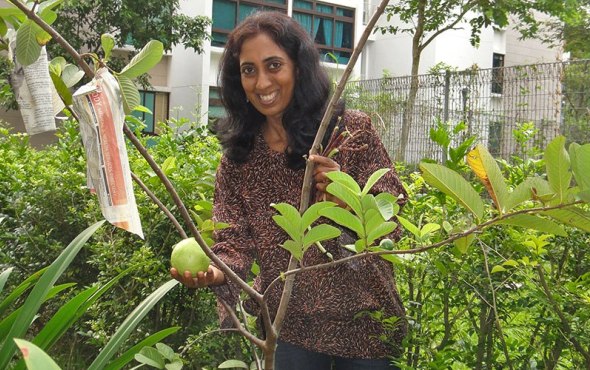
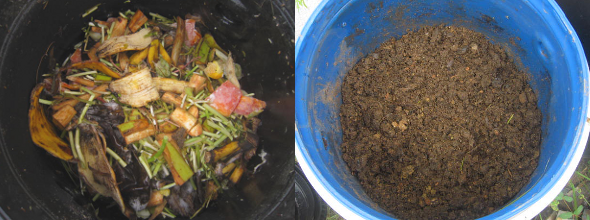
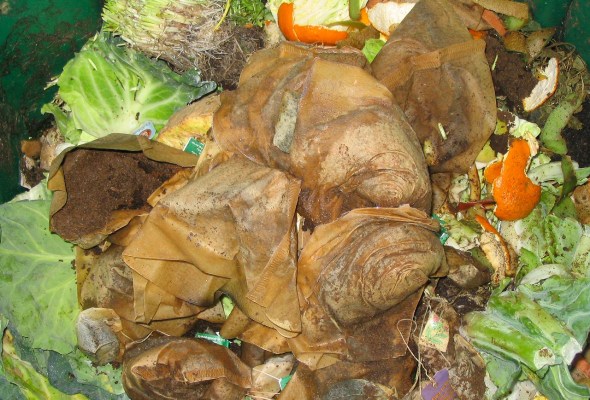
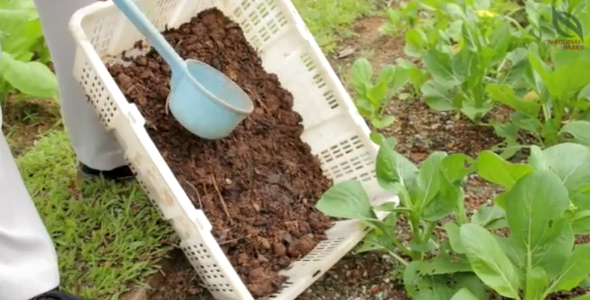




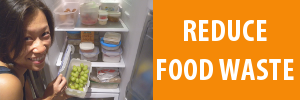



Hi! Are there any communal compost heaps in Singapore that I can add my food scraps to? I live in an HDB flat and I don’t have a garden, nor the space and time to make my own compost, but I’d like to start storing my vegetable scraps in a freezer bin and do weekly contributions to a communal compost heap.
I am very much in the green home initiative movement. Would like to find out where can I purchase compost bins in Singapore? Lots available online but would like to purchase from local supplier.
Consider that if you currently tend to buy bagged, pre-prepped vegetables, such as broccoli florets, it may be time to give up this habit. What happens to the stalk from the broccoli that gets pre-prepped and bagged? If we are serious about sustainability, it is a necessity to address this waste.
I starts to look at natural way compose my vegetables scarps. But theres a issue as im living in apartment as a tenant is hard for me to keep all the wasate in the house.
Is there ay way that i can have contact of someone who are composing items so i can bring it to them maybe every 1 or 2 weeks?
Would be great to cut down the waste prevent it end up in the landfill
I wanted to try as i eat quite a lot of fruits. I want to use fruits peels and at times some vege scraps. I am staying in hbd flat, my concern is will it attract ants? Or any other insects? Cos the fruit peels mayb be sweet unlike vege scraps. Pls advise .
Can I start with just mixing into my normal balance soil or I really need to get the compost as a starter?
Where can I get wood chips at a low cost? They are so expensive to buy from the nurseries.
Thank you
Best
Daniel